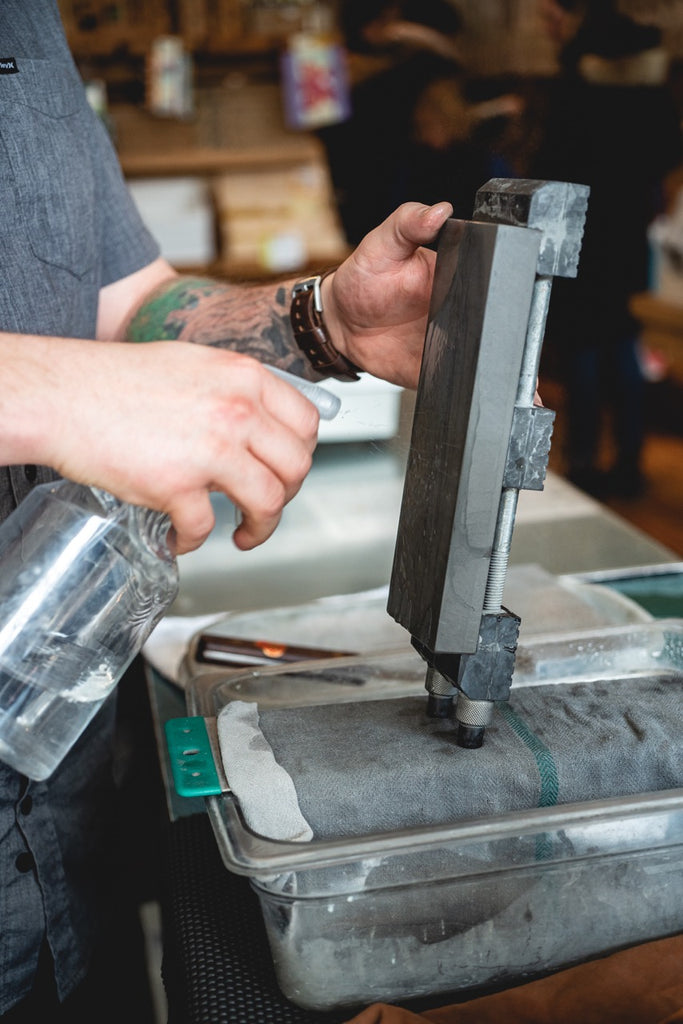Blog
How to sharpen your Japanese knives ?
Owning a Japanese knife is also a commitment to care for it. Even if they are known to be the sharpest and most durable knives, as for any high-end product, it is necessary to know the best practices to preserve them.
Here are our tips to become an expert in the art of sharpening!
Tips to maintain your Japanese knives
- Wash your knives by hand (no dishwasher!)
- Wipe and dry your knives before storing them
- Do not use the abrasive side of sponges
- Sharpen your knives regularly with a leather block
- Sharpen your knives on a water stone once or twice a year
This last point is particularly important: a well-sharpened knife will be sharper and cut more easily, without needing to apply pressure.
How to recognize a dull knife?
The duller the knife, the more metal has to be removed during sharpening. The outcome: the blade loses its durability: hence the importance in taking care of your knives regularly! So how do you know when it's time to sharpen? First thing to do: examine the condition of your blade. If it snags or has trouble slicing, if the blade loses its bite or slips on a tomato: it's time to sharpen.
Sharpening with a water stone
The traditional Japanese whetstone (or “water stone”) sharpening is the best technique. Before you start, you must first select the type of stone but also determine the angle of sharpening of the knife to obtain the desired result.
What type of stone should I use?
There are two types of water stones: the traditional soaking stones that need to be immersed and the "splash and go" stones that just need to be sprayed. In both cases, you will need to moisten them before using them. Make sure the stone is lubricated at all times when sharpening and if there is no more water on the stone, put some back on! Depending on the condition of your blade and the type of knife, you will not use the same stones. Does your blade have micro cracks? Are there any imperfections? Do you just need to polish it? These are all questions to ask yourself when selecting the right stone: the more damaged the blade, the coarser the grain of the stone should be.
What is the right sharpening angle?
As for the sharpening angle, it all depends on the shape and wear of your knife. For Japanese knives, we tend to recommend a sharpening angle between 12 and 18 degrees, but for a European knife we would recommend around 15 to 25 degrees. Moreover, if a knife has been used for several years, the angle will not be the same as if it were new. To find the ideal angle, simply lay the knife flat and gradually increase the angle until the blade bites into the sharpening stone (or leather). If you have any questions or if you are unsure about the type of stone to choose, do not hesitate to contact us or visit our store so that we can advise you in the best possible way.Discover our selection of Japanese stones.

Our sharpening service: Trust us with your knives!
Your knives could use a sharpening session but you don't know where to start? Let one of our professionals do it for you! We offer a sharpening service for all types of knives, even those that were not purchased from us, regardless of the type of blade. Your knives will get all the attention they deserve with a water stone sharpening, the traditional Japanese technique. You can bring your knives to us:
- In store
- By mail
If you have any questions, please contact us by email or by phone.
Don't wait any longer and come get your favorite knives sharpened.

Become a sharpening pro
How about learning how to perfectly sharpen your knives at home? During an hour and a half, our team will give you all the secrets and techniques to learn how to sharpen your knives correctly. No need for technical knowledge, beginners are welcome. During this course, you will learn the right gestures and right angle to sharpen your knives, but also advice on what stones are adequate for your needs. In addition to the practical part, you can also benefit from all the advice and knowledge of our team of professionals. The only requirement is that you bring your own sharpening stone and polishing stone, otherwise you will have to buy one at the store. Good mood and sharpness guaranteed!
Book your next sharpening class.

Olivier's advice:
I recommend sharpening your Japanese knives once or twice a year as needed. Use leather for the daily maintenance of your knives. It is imperative that you understand how sharpening works before you do it yourself. A bad sharpening can unfortunately disintegrate the knife prematurely. Contact an expert if you have any doubts about your technique.
